This post may contain affiliate links. Please read our disclosure policy.
How to juice a lemon with or without a juicer, using one of the 6 methods below! Including top tips to get every last drop and how to freeze lemon (juice, slices, and whole) for longer-term storage!

Whether you’re a big fan of homemade lemonade or love to add lemon to brighten up the flavor of countless other meals, learning how to juice a lemon without a juicer is an essential life skill in my lemon-loving opinion. In fact, while I’ve included the juicer method below, I’ve included five other methods for you to choose from! As a bonus, many work with other citrus fruit, like how to juice limes, too!
Plus, with plenty of top tips, you’ll be able to get every last drop of juice and even use the leftover peel/pith! Best of all, I’ve included how to store lemons in the freezer: whole, sliced, or just the juice! To make the most of this zesty, healthful fruit!
Once juiced, you can use the fresh lemon juice to whip up large batches of homemade lemonade (including flavored mint lemonade, Brazilian cream lemonade, pineapple lemonade, etc.). I also love using it for garlic lemon pasta, lemon garlic butter sauce, lemon chia Fresca, preserved lemons, etc.!

Want to save this recipe?
What’s needed
- Lemons: use whatever lemons you have to hand, though Meyer lemons are a super juicy, slightly sweeter variety I love for lemonade, etc. It’s best to use organic, unwaxed lemons wherever possible, especially when you plan to consume the zest.

You will also need:
- To juice: once again, there are several tools you’re able to use for this. Including an electric juicer, manual lemon squeezer/citrus reamer, a fork/spoon, stand mixer, microwave, or a simple skewer!
- To zest: you can use several tools, including a cheese grater or simply a sharp paring knife. Check my blog post How to Zest Lemon for all the tips!
While this is optional, I highly recommend zesting/peeling the lemon before juicing it to make the most of the ingredient.
For any method that slices the lemons, you’ll also need a cutting board and sharp knife.
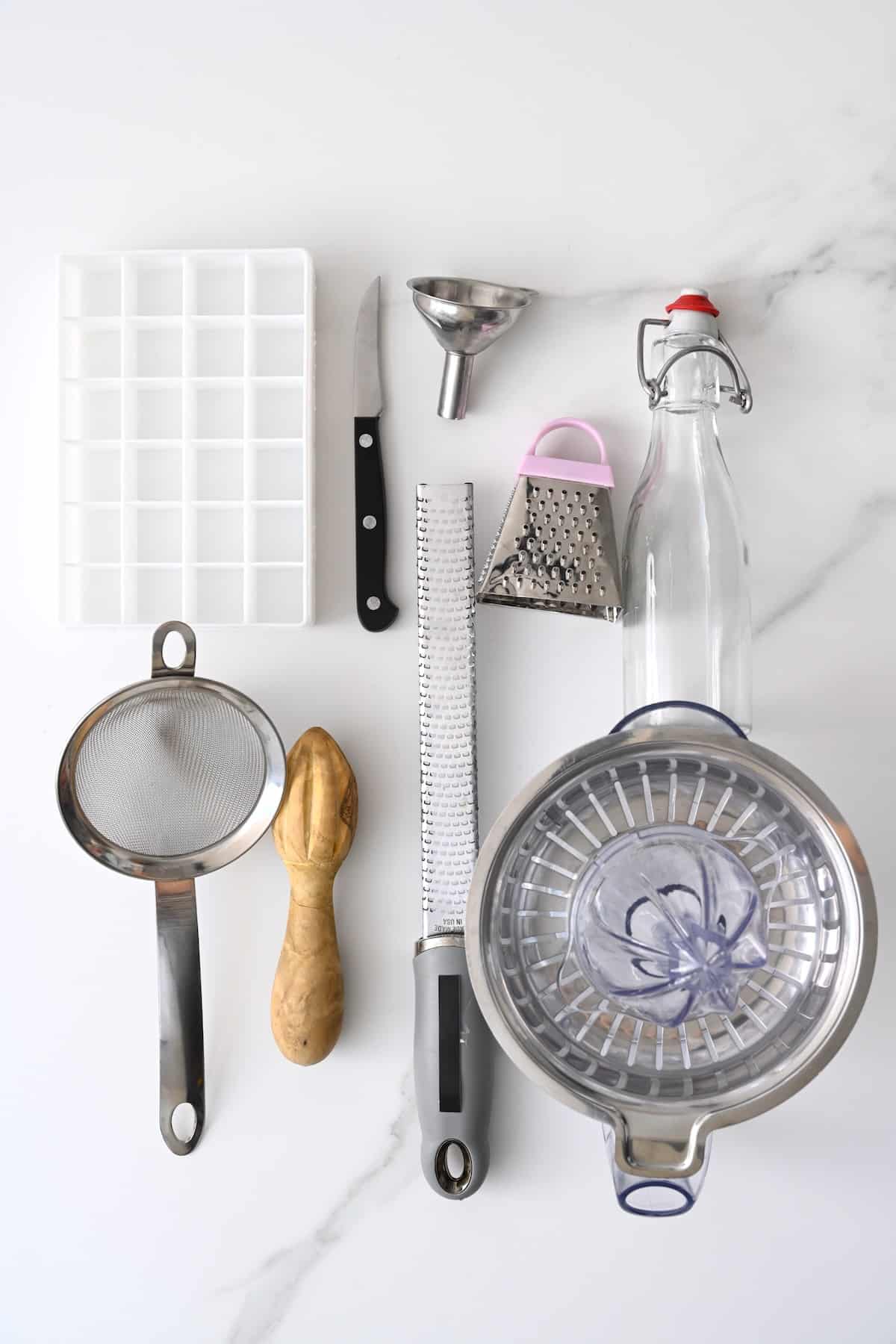
Top tips to extract the most juice
- Zest it first: even if you have no immediate use for it, it’s always best to zest/peel the lemons before juicing (it’s easier to do it in this order). As a bonus, the fruit is even easier to squeeze without the peel!
- Work with room temperature lemons: this helps soften the interior for easier squeezing.
- Microwave it: microwaving your lemon/s (whole) for just 15-25 seconds will help loosen the membranes and juice within and soften the lemon (which makes them easier to squeeze). I usually follow up this step with the next one (rolling).
Alternatively, you can place the lemons in a bowl of hot water for a couple of minutes until the skin is warm.
- Roll it: I always do this before juicing a lemon. Simply roll it on your countertop back and forth several times to help break up and squeeze some of the membranes and get the juice loose and ready to squeeze!
- Cut lengthwise: unless you’re using an electric/manual juicer fit for widthwise lemon halves, many methods will benefit from the lemons being cut lengthwise instead, as there’s more open flesh to juice.

How to juice lemons with and without a juicer
With an Electric Juicer
This method is the easiest of the bunch and is practically effortless! If you’re someone who makes a lot of lemonade (or other recipes where large quantities of fresh lemon juice are required), then it may be worth investing in.
However, note that some people believe hand-squeezed lemon juice is superior as there’s less risk of bitterness from the pith ending up in the juice and usually more oils from the peel.
- Simply slice the lemons in half and press each half against the electric juicer until fully juiced.
The machine will naturally strain the pulp and seeds, so the juice is immediately ready to use (or freeze).
Using a Handheld/Citrus Juicer
A manual juicer is an option many of us have, which can be the same shape as an electric one, but we need to put in the arm work to get those lemons juiced!
- First, use the methods mentioned in the tips section above – microwave (for 20-30 seconds) and/or roll the lemon (on the countertop, back and forth) to loosen up and soften the lemon as much as possible.
- Then, cut the lemon/s in half, place the center of each half over the reamer or the juicer, and press, squeeze and twist the lemon until all the juice is extracted.
Some manual juicers are tabletop versions that still automatically strain the seeds/pulp from the juice. Others, like the handheld “reamer” photographed, do not. When using the latter, you could place a strainer over the jug/bowl you’re juicing the lemons over. That way, you don’t need to strain it afterward .
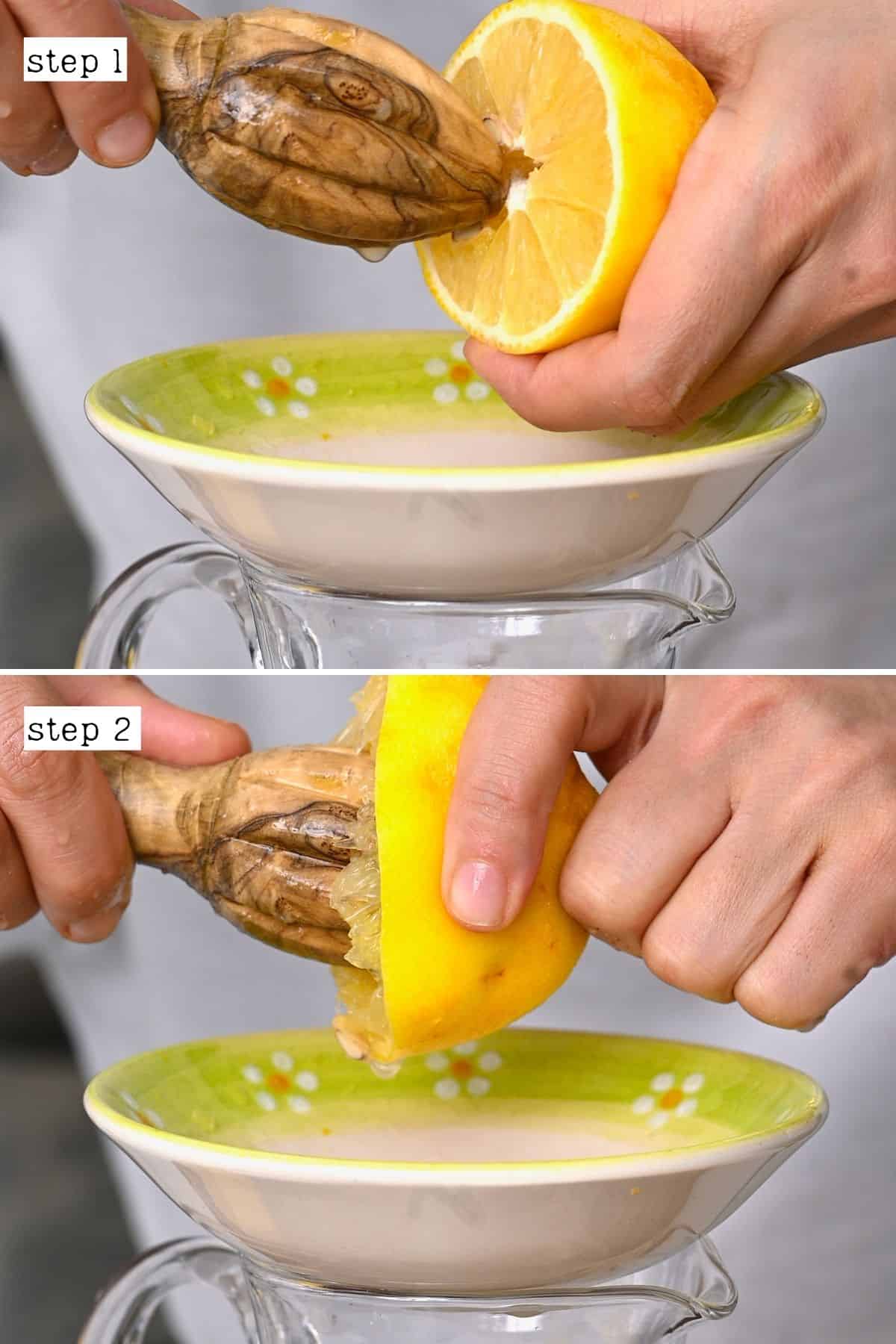
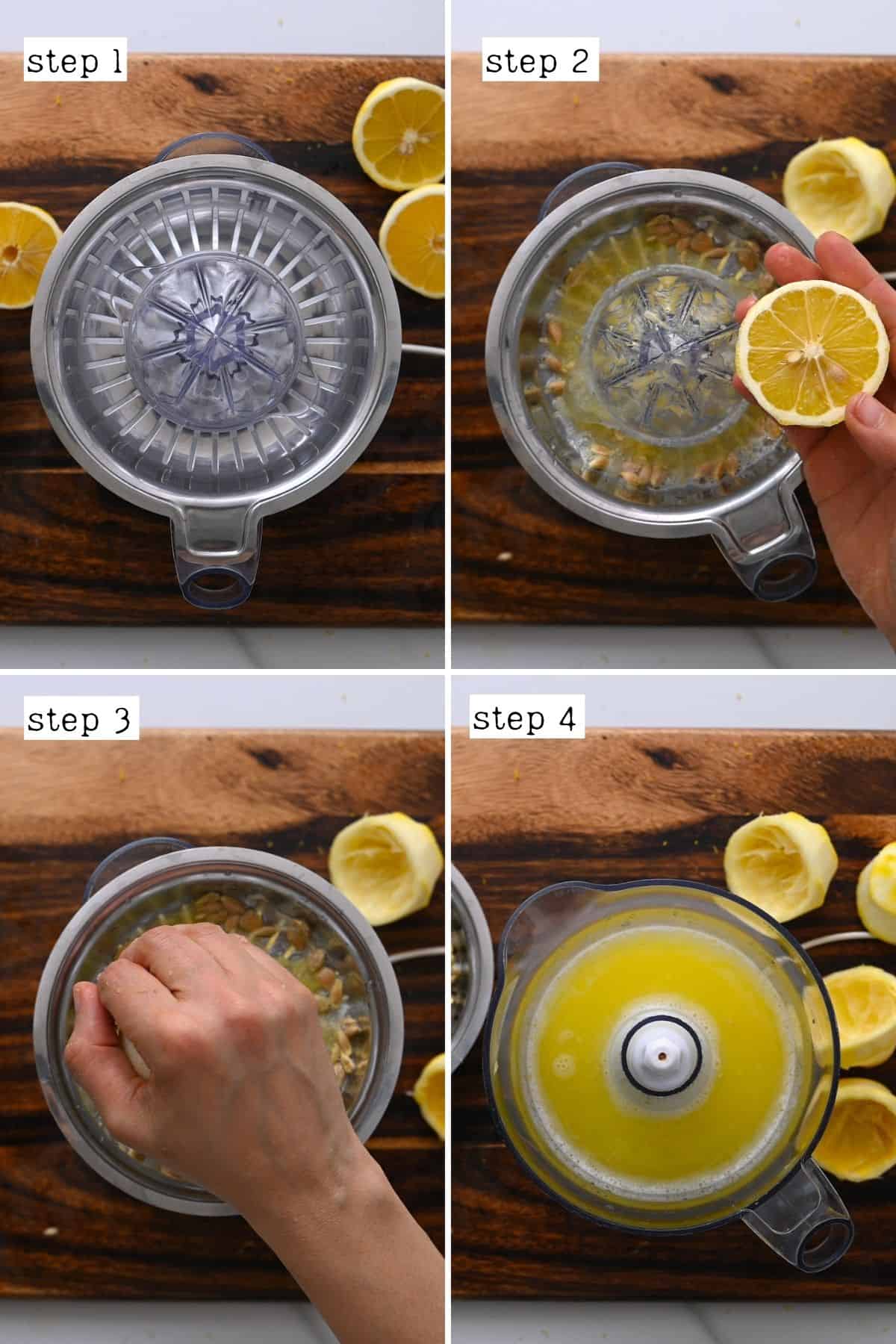
With a Fork or Spoon
For those who have no particular tool, did you know that you can juice lemons with a spoon or fork? Here’s how:
- First, use the methods mentioned in the tips section above – microwave (for 20-30 seconds) and/or roll the lemon (on the countertop, back and forth) to loosen up and soften the lemon as much as possible.
I always do this for the tool-free option, as it really helps to make the job easier and extract as much juice as possible from the lemons.
- Then, chop the lemon in half and place it over your bowl/container of choice (placing a fine-mesh sieve over that will help strain the pulp and seeds).
- Pressing a spoon or fork into the center of each half, squeeze and twist. The spoon or fork will work similarly to the handheld reamer and will crush the remaining membranes inside and release the juice.
Using a Stand Mixer
Okay, I’ll admit, this method was odd even for me. But when I tried it and it actually worked… Who knew?! While it’s usually my last resort (more cleanup and mess!), the fact that more of the skin oils are infused into the juice makes it extra zippy!
- First, slice the lemon/s in quarter lengthwise wedges and place them in the bowl of your stand mixer.
- Then, cover the bowl with a layer of plastic wrap (or use a splatter guard) and turn the mixer on low, allowing it to squeeze and crush lemons until they look thoroughly juiced.
- Then, pour the juice through a strainer.
The Freezer Method
While this isn’t an option I use often, it can help with hard, dry lemons.
- Simply pop the lemon in the freezer. Then, when needed, allow it to thaw entirely at room temperature before juicing with your method of choice.
Alternatively, you can thaw the lemons in a cold water bath (for around 20 minutes) or even in the microwave.
How does this work? The freezing/thawing process breaks the membranes within the lemon as they expand upon freezing and makes it super juicy once thawed, so it’s easier to extract the juice manually (with a fork/spoon or simply by hand).
Without Cutting the Lemon
This “hack” went viral online in the last year or two, with mixed reactions. I don’t think it’s the most efficient way to juice a lemon, but it works when following the correct steps.
This method is best when you need a small amount of juice, and you can then save the leftover lemon without as much risk of it drying out. Plus, it’s mess-free, with no need for knives, chopping boards, etc.
- First, use the methods mentioned in tips section above – microwave (for 20-30 seconds) and/or roll the lemon (on the countertop, back and forth) to loosen up and soften the lemon as much as possible. This will make it easier to squeeze.
- Then, using a skewer, chopstick, or thick toothpick, pierce the non-stem end of the lemon. Press it as far into the lemon as you can without going all the way through.
- Then, hold the lemon over your container (optionally place a strainer first, though this method shouldn’t allow much pulp/seeds to escape the lemon) and squeeze. The juice should stream out through the hole.
How much lemon juice is in one lemon?
This will depend on the size of the lemon. A medium-sized lemon usually provides around 3 tablespoons of juice. A large lemon will usually yield about 4 tablespoons of fresh lemon juice.
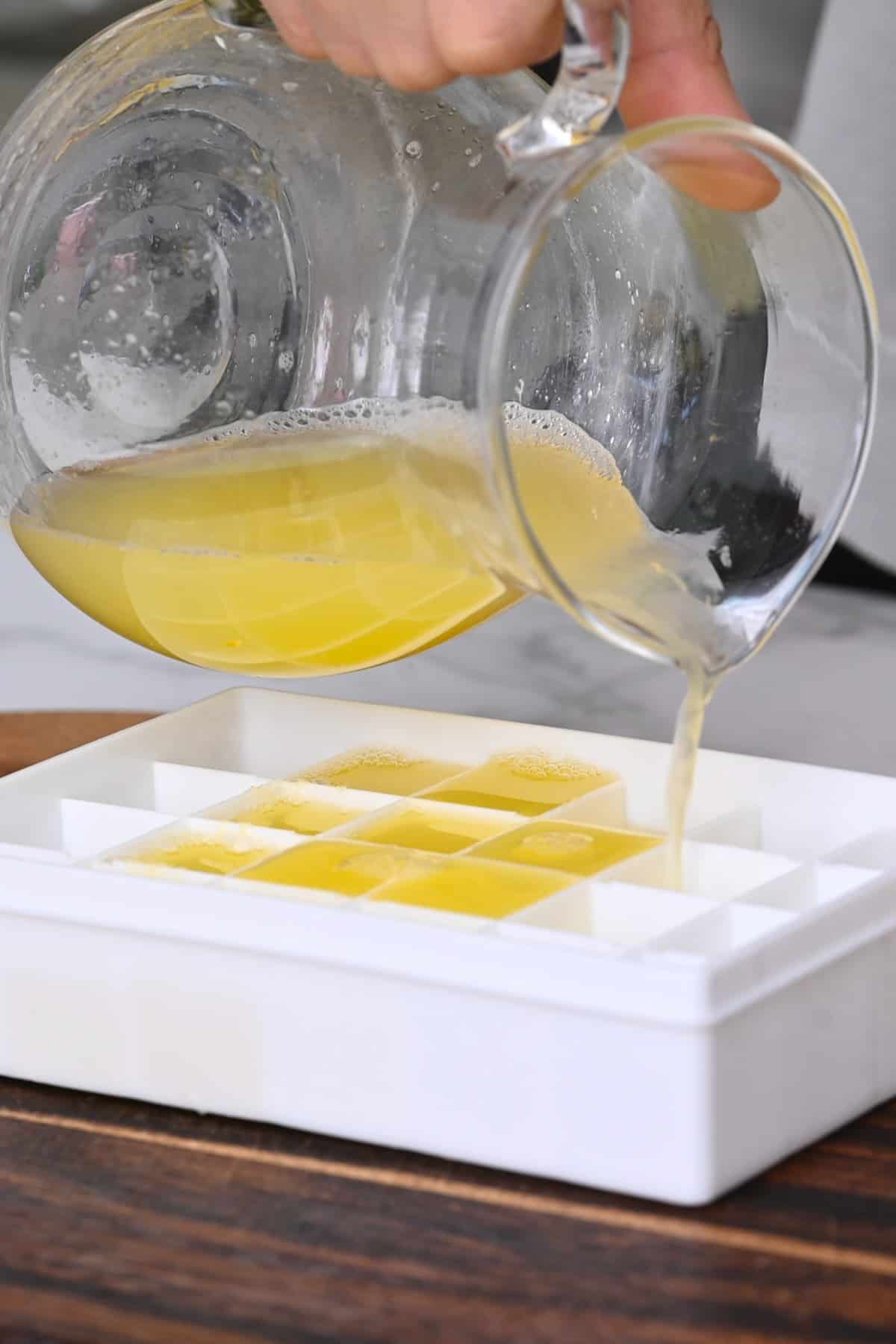
How to store and freeze?
To store in the refrigerator: fresh lemon juice will last 2-3 days in an airtight container in the refrigerator. However, it tends to get more bitter as it sits, so it’s best to freeze it for long-term storage.
How to freeze juice: there are two ways to freeze the fresh lemon juice that I use. The first option pours it into a jar with ½-inch of headspace. The second option portions the juice into an ice cube tray. Freeze until solid, then transfer the lemon ice cubes to an airtight container/reusable Ziplock bag for between 3-4 months.
As a bonus, lemon ice cubes can be added directly to lemonade and other drinks to chill without diluting them!
Lemon slices: while you can freeze them whole, I prefer to rinse, dry, and make thin slices. Arrange them on a parchment or plastic-lined baking tray and freeze until solid. Then transfer to a reusable Ziplock bag and freeze for 3-4 months. These slices are perfect for adding to drinks as a garnish and will release their juice as they thaw.
Alternatively, you can freeze the lemons whole!
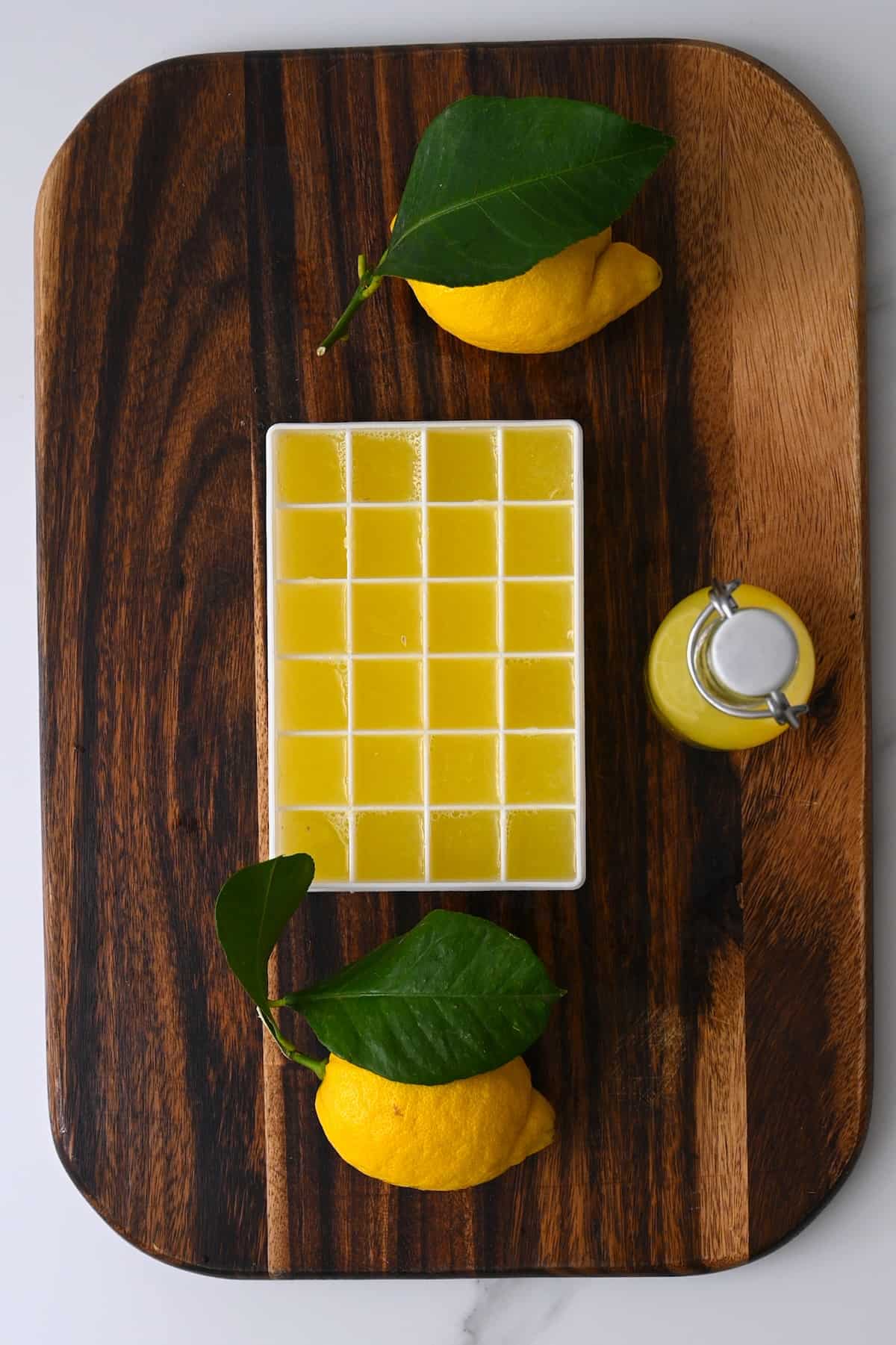
How to use lemon pith/peel?
If you didn’t zest/peel the lemon/s before juicing (that way, it can be candied, added to baked recipes, marinades, sauces, etc.), there are still several ways to avoid wasting this zesty ingredient, including:
- Preserve them: make preserved lemons by combining some juice with the peels and PLENTY of salt. Check my post for the full method! Or make candied lemon slices.
- Make an all–purpose cleaner: I’ve shared how to make an all-purpose cleaner with orange peels, but it will also work with lemon (or a combination).
- Use for other cleaning: you can use lemon peels for cleaning and adding a fresh fragrance to homemade cleaning. For example, when you clean the microwave or clean the oven.
- For deodorizing: such as in your sink disposal or your bin (place the peel minus the pith under your garbage bag in the bin).
- Compost them: while they take a while to break down, they ARE compostable. I recommend slicing them into tiny pieces first, though.
- Dehydrate them: slice the leftover rinds and then use a paring knife to peel them, leaving the pith behind. You can then dehydrate the peel/lemon zest on a drying rack or dehydrator/oven. Once dry, add to tea, potpourri, make lemon pepper, etc.
Other juice recipes
- Apple Juice
- Orange Juice
- Watermelon Juice (4 methods)
- Tomato Juice (3 methods)
- Cucumber Juice (3 methods)
- Kiwi Juice
- Carrot Juice
- Peach Juice (Peach Nectar | 2 Methods)
If you try one of these methods for how to juice a lemon, I’d love to hear your thoughts/questions below. Also, I’d appreciate a recipe card rating below, and feel free to tag me in your recipe recreations on Instagram @Alphafoodie!

How to Juice a Lemon (6 Methods With + Without Juicer | + Freeze it)
Equipment
Ingredients
- 1 lemon or as many as needed
1 medium lemon will yield about 3 Tbsp/45 ml.
Instructions
With an Electric Juicer
- Simply slice the lemons in half and press each half against the electric juicer until fully juiced.The machine will naturally strain the pulp and seeds, so the juice is immediately ready to use (or freeze).
Using a Citrus Juicer or a Handheld Reamer
- Use the methods mentioned in the Notes section below – microwave (for 20-30 seconds) and/or roll the lemon (on the countertop, back and forth) to loosen up and soften the lemon as much as possible.
- Cut the lemon/s in half, place the center of each half over the reamer or the juicer, and press, squeeze and twist the lemon until all the juice is extracted.Some manual juicers are tabletop versions that still automatically strain the seeds/pulp from the juice. Others, like the handheld "reamer" photographed, do not. When using the latter, you could place a strainer over the jug/bowl you're juicing the lemons over. That way, you don't need to separately strain it through a juicer afterward.
With a Fork or Spoon
- Use the methods mentioned in the Notes section below – microwave (for 20-30 seconds) and/or roll the lemon (on the countertop, back and forth) to loosen up and soften the lemon as much as possible.
- Cut the lemon in half and place it over your bowl/container of choice (placing a fine-mesh sieve over that will help strain the pulp and seeds).
- Pressing a spoon or fork into the center of each half, squeeze and twist. The spoon or fork will work similarly to the handheld reamer and will crush the remaining membranes inside and release the juice.
Using a Stand Mixer
- Slice the lemon/s in quarter lengthwise wedges and place them in the bowl of your stand mixer.
- Cover the bowl with a layer of plastic wrap (or use a splatter guard) and turn the mixer on low, allowing it to squeeze and crush lemons until they look thoroughly juiced.
- Pour the juice through a strainer, giving each lemon half one more last squeeze manually.
The Freezer Method
- Simply pop the lemon in the freezer. Then, when needed, allow it to thaw entirely at room temperature before juicing with your method of choice.Alternatively, you can thaw the lemons in a cold water bath (for around 20 minutes) or even in the microwave.
Without Cutting the Lemon
- Use the methods mentioned in the Notes section below – microwave (for 20-30 seconds) and/or roll the lemon (on the countertop, back and forth) to loosen up and soften the lemon as much as possible. This will make it much easier to squeeze.
- Using a skewer, chopstick, or thick toothpick, pierce the non-stem end of the lemon. Press it as far into the lemon as you can without going all the way through.
- Hold the lemon over your container (optionally place a strainer first, though this method shouldn't allow much pulp/seeds to escape the lemon) and squeeze. The juice should stream out through the hole.
How To Store and Freeze?
- To store in the refrigerator: fresh lemon juice will last 2-3 days in an airtight container in the refrigerator. However, it tends to get more bitter as it sits, so it's best to freeze it for long-term storage. How to freeze juice: there are two ways to freeze the fresh lemon juice that I use. The first option pours it into a jar with ½-inch of headspace. The second option portions the juice into an ice cube tray. Freeze until solid, then transfer the lemon ice cubes to an airtight container/Ziplock bag for 3-4 months. As a bonus, lemon ice cubes can be added directly to lemonade and other drinks to chill without diluting them!Lemon slices: while you can freeze them whole, I prefer to rinse, dry, and make thin slices. Arrange them on a parchment or plastic-lined baking tray and freeze until solid. Then transfer to a reusable Ziplock bag and freeze for 3-4 months. These slices are perfect for adding to drinks as a garnish and will release their juice as they thaw.
Notes
- Zest it first: even if you have no immediate use for it, it’s always best to zest/peel the lemons before juicing (it’s easier to do it in this order). As a bonus, the fruit is even easier to squeeze without the peel!
- Work with room temperature lemons: this helps soften the interior for easier squeezing.
- Microwave it: microwaving your lemon/s (whole) for just 15-25 seconds will help loosen the membranes and juice within and soften the lemon (which makes them easier to squeeze). I usually follow up this step with the next one (rolling). Alternatively, you can place the lemons in a bowl of hot water for a couple of minutes until the skin is warm.
- Roll it: I always do this before juicing a lemon. Simply roll it on your countertop back and forth several times to help break up and squeeze some of the membranes and get the juice loose and ready to squeeze!
- Cut lengthwise: unless you’re using an electric/manual juicer fit for widthwise lemon halves, many methods will benefit from the lemons being but lengthwise instead, as there’s more open flesh to juice.
Nutrition
Nutrition information is automatically calculated, so should only be used as an approximation.
















